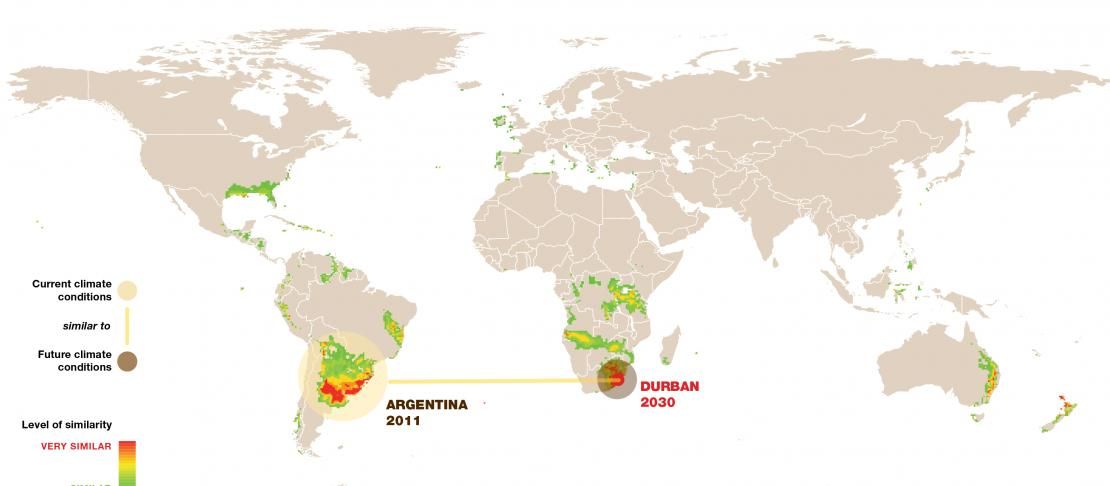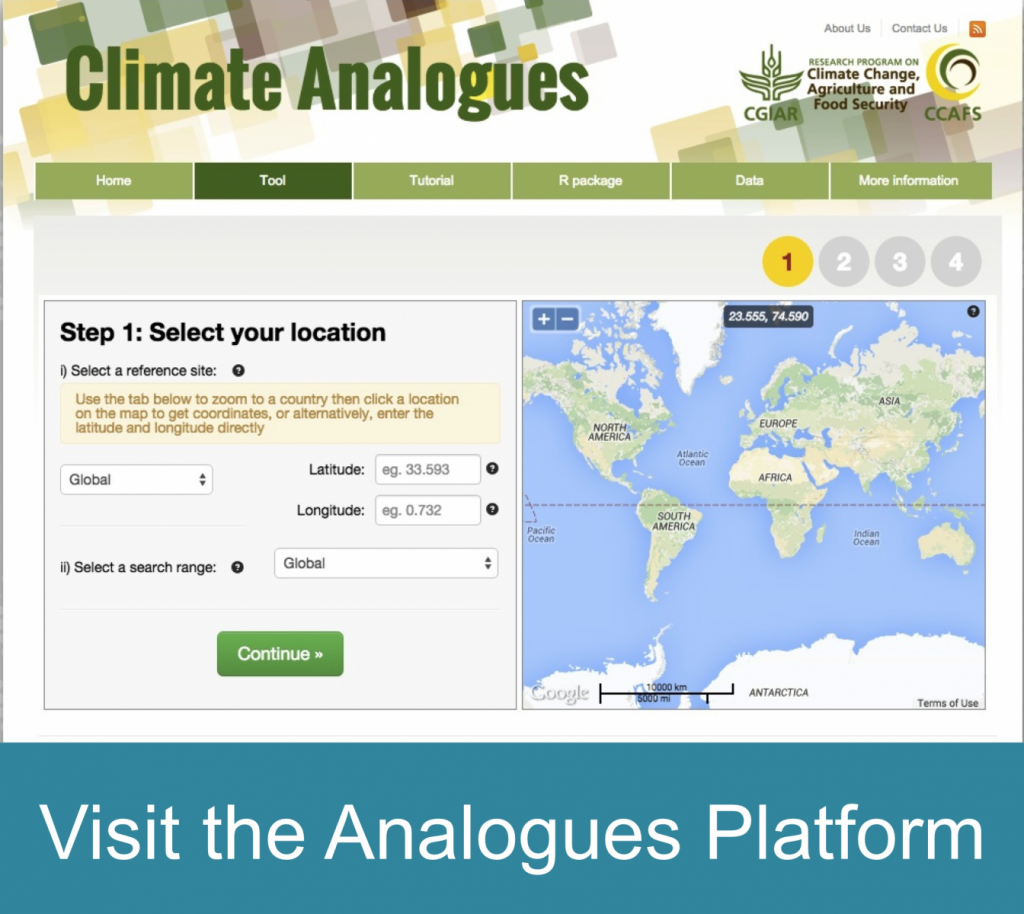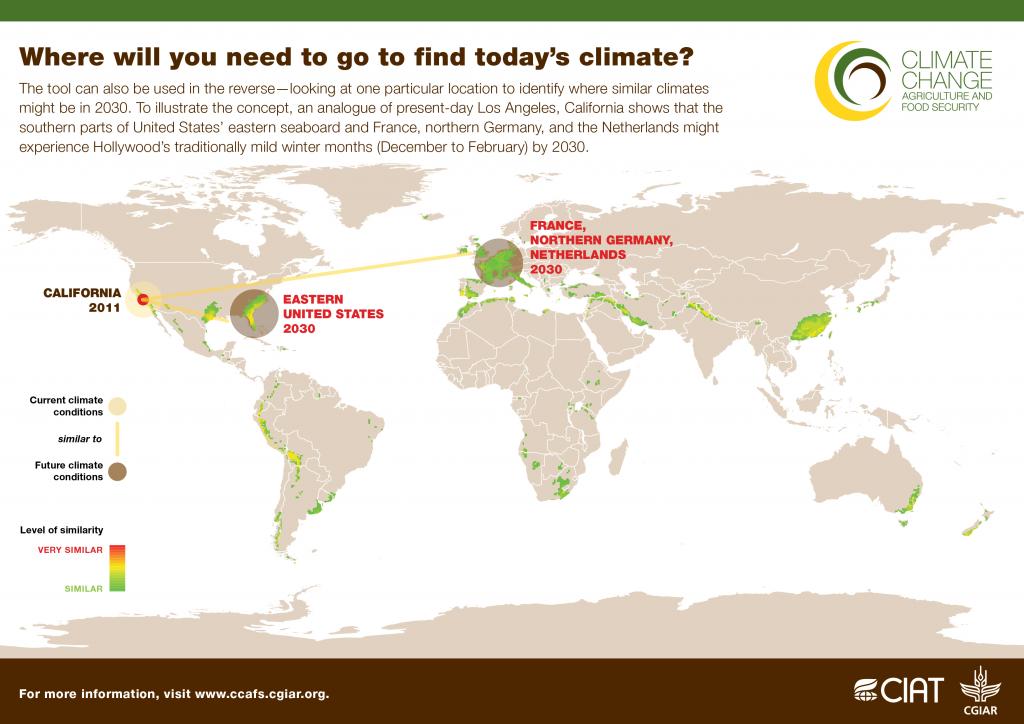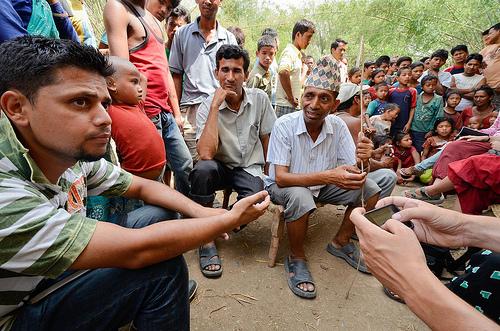Climate Analogues

Finding tomorrow’s climate adaptation solutions today
 It is no great secret that climate change presents a massive challenge to agriculture. While some regions will develop a climate that favours agriculture, most will not. Even in places where conditions improve, many resource-poor smallholders will be hard pressed to take advantage of the additional production potential while, in areas where conditions deteriorate, farmers will have to adapt to their new circumstances as quickly as possible. This will be particularly difficult for smallholders who completely depend on agriculture for their food and livelihoods.
It is no great secret that climate change presents a massive challenge to agriculture. While some regions will develop a climate that favours agriculture, most will not. Even in places where conditions improve, many resource-poor smallholders will be hard pressed to take advantage of the additional production potential while, in areas where conditions deteriorate, farmers will have to adapt to their new circumstances as quickly as possible. This will be particularly difficult for smallholders who completely depend on agriculture for their food and livelihoods.The CCAFS Climate Analogues Tool
What the analogues tool can tell us:
- Climate models predict a 1°C rise in average temperatures by 2030 during the maize-growing season near the city of Durban, South Africa; this could result in a 20% drop in yield. The analogues tool suggests looking to northern Argentina and Uruguay, where maize farmers are enjoying good yields under average temperatures that are 3°C higher than those around Durban.
- The 2030 climate in a soybean-growing area near Shanghai, China will be similar to current climates in soybean-growing zones in the USA and South America. Farmers in Shanghai can learn from these analogous climates as their own climate shifts.
- An analogue of present day Los Angeles shows that the southeastern USA, France, northern Germany and the Netherlands might all experience southern California’s mild winter climate by 2030, with implications for the agriculture in these regions.
Using one or more global climate models, the analogues tool developed by CCAFS takes climate and rainfall predictions for a particular site and searches for places with similar conditions at present. Armed with the knowledge of what they may face in future, farmers, researchers and policy makers can determine their adaptation options based on real – as opposed to crystal ball-gazing – models. The tool can also track historical data to learn how communities have adapted – or have failed to adapt – to climate change over time. Importantly, it helps capture the real world capacity of farmers to adapt, which is too often not taken into account in catastrophic climate models. Users of the tool – which is available online atanalogues.ciat.cgiar.org/climate – can include variables such as crops, soils and socio-economic indicators in their searches.
Comparing present-day farming systems to their future analogues can facilitate the exchange of knowledge between farmers in different locations who share common climate interests and allows adaptation strategies and technologies to be tested and validated. CCAFS is disseminating the analogues tool widely and training regional, national and local partners to use it, in the hope of expanding its use beyond its project sites. So far, CCAFS has trained nearly 200 researchers from East and West Africa, Europe and Central America.
Practical Applications

WILD RELATIVES OF CURRENT CROPS WILL BE KEY TO FOOD SECURITY IN THE FUTURE. PHOTO: N.PALMER
Farms of the Future

In 2012, researchers used the analogues tool to track locations whose climate was similar to the climate projected for 2030 in Yamba, Tanzania. A small group of Yamba farmers travelled to several analogue locations to see firsthand how farmers were dealing with the climate conditions that lie in Yamba’s future. The Yamba farmers learned about soil and water conservation, tree and coffee nurseries, beekeeping and other practices that they could take back home. They were given video cameras so they could document and share these practices with their families and friends in Yamba. Now, Yamba’s farmers are equipped to manage their own future climate situations. The Tanzania visits were the first in a series of pilots; exchanges have also taken place in Ghana and Nepal with additional visits planned for other countries in East and West Africa and South Asia. The research team returned to Nepal after a year and found that the community that took part in the exchange had adopted some new practices but not others, providing useful insights for future exchanges.

FARMERS FROM BEORA WILL VISIT THEIR “FUTURE CLIMATES” IN WESTERN NEPAL, TO HELP THEM LEARN HOW COMMUNITIES COPE WITH HIGHER TEMPERATURES & DIFFERENT RAINFALL PATTERNS. PHOTO: N.PALMER
Key Links and Resources
Tool: Climate Analogues Platform
Wiki: CCAFS Analogues
Flyer: 'Climate analogues'
CCAFS Working paper: 'Climate analogues: Finding tomorrow's agriculture today'
Blog: East Africa moves towards implementation plans with the Climate Analogues tool
Blog: Climate scenarios and analogues: A glimpse into past, present and future climates
Blog: Climate change models may help spur lawmakers to implement seed treaty
Read more blogs on our Climate Analogues activities